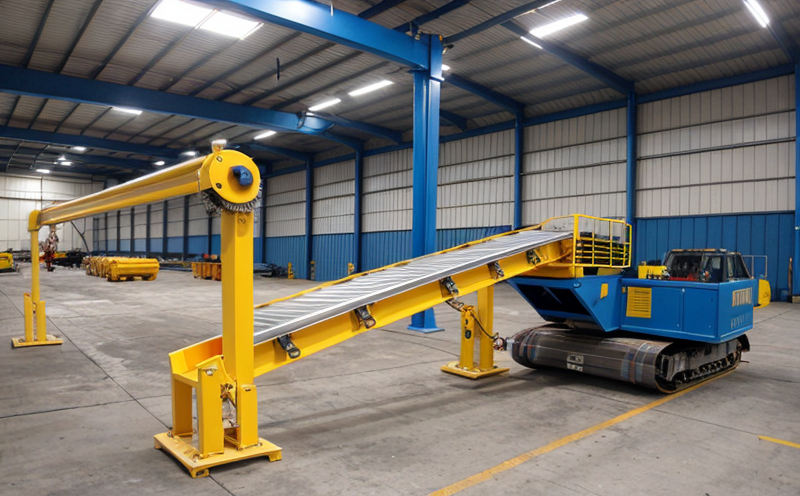ISO 4195 Heat Resistance of Conveyor Belts Testing
The ISO 4195 standard is essential in ensuring that conveyor belts used in mining operations can withstand extreme heat without compromising safety or performance. This testing service is critical for quality managers, compliance officers, R&D engineers, and procurement teams who need to verify the reliability and durability of their conveyor belt materials under high-temperature conditions.
Conveyor belts are integral components in various mining applications, including surface mines and underground operations. They must be capable of withstanding harsh environmental conditions that can significantly affect performance and longevity. The ISO 4195 standard provides a standardized method to determine the heat resistance of conveyor belts, ensuring that they meet the necessary requirements for safety and efficiency.
The testing process involves exposing a sample belt to specified high-temperature conditions in an oven for a defined duration. During this period, the belt is monitored for any signs of damage or degradation. The test aims to evaluate the thermal stability and mechanical properties of the conveyor belt under these conditions. This ensures that mining operations can continue without interruptions due to equipment failures.
The results of this testing are crucial for several reasons:
- Enhanced Safety: Ensuring that belts do not melt or degrade during operational temperatures prevents accidents and potential hazards in the mining environment.
- Durability: By identifying the limits of heat resistance, the testing helps manufacturers improve belt durability, reducing maintenance costs and downtime.
- Efficiency: Reliable conveyor belts contribute to higher production rates and lower operational costs by minimizing disruptions due to failures.
The ISO 4195 standard is widely recognized in both national and international standards, ensuring that the testing process remains consistent and reliable across different regions. This consistency is vital for global mining operations where compliance with international standards can significantly impact business operations.
Our laboratory offers comprehensive testing services aligned with the ISO 4195 standard, providing accurate and reliable results to support your quality assurance efforts. Our team of experts ensures that every test adheres strictly to the prescribed methodology, ensuring confidence in the results provided.
Scope and Methodology
| Parameter | Description |
|---|---|
| Test Specimen Size | A single conveyor belt sample of standard dimensions, typically 10 cm x 30 cm. |
| Temperature Range | The test belt is exposed to temperatures ranging from 25°C to the specified maximum heat resistance temperature for a duration of 3 hours. |
| Environmental Conditions | The testing is conducted in an oven with controlled humidity and airflow, ensuring consistent conditions throughout the test. |
| Specimen Preparation | Belt samples are cut to standard dimensions and conditioned in a temperature-controlled environment for 24 hours before testing. |
| Data Collection | Temperature readings are taken at regular intervals during the test, and visual inspections are conducted every hour to check for any signs of degradation or damage. |
| Acceptance Criteria | The belt is considered to have passed the heat resistance test if it does not show any visible signs of damage or significant changes in properties after exposure to the specified temperature for 3 hours. |
The rigorous testing process ensures that conveyor belts used in mining operations meet the highest standards of reliability and safety. By adhering strictly to ISO 4195, our laboratory guarantees accurate results that can be trusted by quality managers, compliance officers, R&D engineers, and procurement teams.
Environmental and Sustainability Contributions
The ISO 4195 heat resistance testing plays a crucial role in promoting environmental sustainability within the mining sector. By ensuring that conveyor belts can withstand extreme temperatures without degrading or failing, this standard helps reduce operational downtime and maintenance costs. This, in turn, contributes to more efficient operations, which are critical for minimizing environmental impact.
Efficient conveyor belt systems also contribute to reducing energy consumption by optimizing material handling processes. By selecting materials that meet the ISO 4195 standards, mining companies can enhance their sustainability efforts and comply with international environmental regulations. This not only improves operational efficiency but also supports long-term business goals related to environmental responsibility.
The durability of conveyor belts, as ensured through this testing process, leads to longer service life cycles, reducing the need for frequent replacements. This reduces waste generation and the associated environmental footprint, aligning with broader sustainability initiatives in the industry.
Moreover, by ensuring that mining operations are equipped with reliable conveyor belt systems capable of operating under challenging conditions, ISO 4195 testing supports safer work environments and promotes operational continuity, which are essential for sustainable business practices.
Competitive Advantage and Market Impact
The implementation of ISO 4195 heat resistance testing can provide significant competitive advantages in the mining industry. By ensuring that conveyor belts meet or exceed international standards, companies can demonstrate their commitment to quality and safety, thereby gaining a reputation for reliability and trustworthiness.
Meeting these stringent requirements also opens up access to global markets where compliance with international standards is essential. This can enhance brand visibility and market penetration, making it easier for mining operations to attract business partners and clients who value compliance and excellence in product performance.
The ISO 4195 heat resistance testing process not only ensures that conveyor belts are safe and reliable but also contributes to operational efficiency by minimizing downtime due to equipment failures. This can lead to increased productivity, lower maintenance costs, and reduced waste generation, all of which contribute to a stronger competitive position in the market.
In addition, adhering to international standards like ISO 4195 can help mining companies differentiate themselves from competitors by showcasing their commitment to environmental sustainability and operational excellence. This can be particularly advantageous in regions with strict regulatory requirements and growing consumer demand for sustainable products and services.





